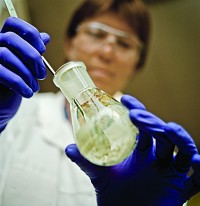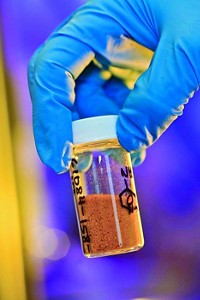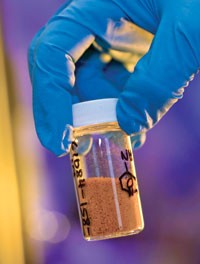Advertisement
Grab your lab coat. Let's get started
Welcome!
Welcome!
Create an account below to get 6 C&EN articles per month, receive newsletters and more - all free.
It seems this is your first time logging in online. Please enter the following information to continue.
As an ACS member you automatically get access to this site. All we need is few more details to create your reading experience.
Not you? Sign in with a different account.
Not you? Sign in with a different account.
ERROR 1
ERROR 1
ERROR 2
ERROR 2
ERROR 2
ERROR 2
ERROR 2
Password and Confirm password must match.
If you have an ACS member number, please enter it here so we can link this account to your membership. (optional)
ERROR 2
ACS values your privacy. By submitting your information, you are gaining access to C&EN and subscribing to our weekly newsletter. We use the information you provide to make your reading experience better, and we will never sell your data to third party members.
Business
Pharma’s Next Transformation
Companies continued to overhaul R&D amid tepid fourth-quarter results
by Lisa M. Jarvis
February 28, 2011
| A version of this story appeared in
Volume 89, Issue 9

Patent expiries, stalled new-drug pipelines, pricing pressures, and health care reform costs created pain for drug companies in both the fourth quarter of 2010 and the full year. Due in part to the arrival of generic competition to key products in the year’s second half, fourth-quarter profits dropped at more than half of the 11 drug firms C&EN tracks.
Despite the already deep cuts made across the pharmaceutical industry from 2008 to 2010, several companies are starting out 2011 with fresh layoffs and site closures as they continue to grapple with the tough operating environment.
“The macroeconomic challenges of 2010 are continuing into 2011, and some will get even more difficult, including increased European austerity measures and higher-than-anticipated U.S. health care reform costs,” Merck & Co.’s chief executive officer, Kenneth C. Frazier, told investors when the company released earnings earlier this month.
Those challenges have pushed many companies to yet again rethink their approach to research. “We’ve got to get better at R&D,” Sanofi-Aventis CEO Christopher A. Viehbacher told investors earlier this month. Drug companies and the National Institutes of Health spent $63 billion on R&D last year, he pointed out, yet only 22 drugs were approved. “We can’t keep going like that, and I think you’re starting to see companies taking ever-more-radical approaches,” he said. “I don’t think we’re done yet either in terms of thinking about things differently.”
Pfizer had the most to say about overhauling R&D in light of its annual results. The drug giant’s fourth-quarter sales were up 6.2% to $17.6 billion, but profits fell 1.4% to $3.8 billion. For the full year, sales increased 35.6% to $67.8 billion, based on a 26.6% bump in profits to $18.0 billion.
But the robust results were an artifact of Pfizer’s acquisition of Wyeth: Without the contribution of Wyeth products, the company’s sales would have fallen by 7% in the fourth quarter and 3% for the year. Pfizer’s fourth-quarter performance also got a healthy boost from sales in emerging markets; even with Wyeth, U.S. sales were down 3% compared with the 2010 period.
The slide in sales of legacy Pfizer products is largely due to new generic competition for its cholesterol drug Lipitor in Spain and Canada. Sales of Lipitor, Pfizer’s top-selling drug, were down 17% in the fourth quarter to $2.6 billion and down 6% for the full year to $10.7 billion.
The pain will only get worse. Lipitor loses U.S. patent protection in November, and stock analysts predict generic drugs will quickly cannibalize sales. BMO Capital Markets forecasts annual Lipitor sales will plummet to $5.5 billion in 2012, while Bernstein Research predicts sales will drop to $4.6 billion.
Given the rapidly approaching Lipitor sales cliff and the challenges in the health care marketplace, Pfizer’s new CEO, Ian Read, took a red pen to spending. In its earnings report, Pfizer said it will close its Sandwich, England, research site, which employs 2,400 people, and cut 25% of the 4,400 jobs at its Groton, Conn., labs. Pfizer is also narrowing its research focus to several core areas: neuroscience, cardiovascular health, metabolic and endocrine diseases, inflammation and immunology, oncology, and vaccines. It is ending research in allergy and respiratory medicine, internal medicine, oligonucleotides, tissue repair, and antibacterials.
The layoffs add to the 15% reduction to its staff of 128,000 that Pfizer made after its purchase of Wyeth. It had already exited research in anemia, bone health, obesity, gastrointestinal disease, and some cardiovascular diseases. After the Wyeth acquisition, it closed six of its 20 research sites.
In announcing the changes, Read said a new R&D culture would accompany the cuts: “I fundamentally believe in the power of innovation in pharmaceuticals, but I recognize to be successful over time, we need to substantially improve the rigor of our approach.” The streamlined research arm will be a “result-driven and entrepreneurial organization,” Read said.
Pfizer said it will no longer conduct research in areas with poor return on investment, and it will inject more accountability into the daily activities of its scientists.
Investors reacted positively to Pfizer’s R&D overhaul. The “solid, strategic cuts” meant Pfizer did not have to lower its 2012 earnings-per-share estimate, said BMO Capital Markets analyst Robert Hazlett. Analysts also seemed happy that Pfizer is getting out of disease areas where research has yielded little, saving $2.5 billion in annual R&D costs in the process.
Pfizer’s new approach to R&D is similar to the one GlaxoSmithKline has rolled out over the past two years. The British company changed how it spends its research dollars, focusing on lowering risk through external partnerships, reducing its R&D footprint, and ending activities in areas deemed too risky or with too low of a return.
Time will tell whether the actions will accomplish GSK’s goal of reinvigorating its pipeline. In the meantime, 2010 was a tough year. The firm posted a loss of $299 million in the fourth quarter, and sales fell 11.1% to $11.1 billion. For the year, sales were flat at $43.9 billion, while earnings were halved to $4.6 billion. Like Pfizer, GSK offset poor results for its traditional pharmaceutical business in the U.S. and Europe, where annual sales were down 11% and 6%, respectively, with significant growth in emerging markets.
Several culprits were behind GSK’s weak results. After years of debate over the safety of the diabetes drug Avandia, the U.S. Food & Drug Administration placed severe restrictions on its use. In Europe, regulators pulled the drug from the market altogether. Sales of Avandia fell to $682 million from $1.2 billion in 2009. The drug had brought in $3 billion in 2006.
GSK was also hit by generic competition for its herpes treatment Valtrex, which saw sales fall to $825 million from $2.0 billion in 2009. Finally, results were affected by a drop in demand for the flu treatment Relenza, which had sales of $188 million, down from $1.1 billion in 2009.
“There’s no question that this environment is a tough one, and you only have to look at every other company’s reports in the last two or three weeks and you get very much the same sense of people being under pressure in this sector,” GSK CEO Andrew Witty told investors when the earnings were released. “What’s key are which companies are going to emerge from this period first.”
Witty pointed out that GSK anticipated many of the current challenges and prepared accordingly over the past several years. The overhaul of its research organization was intended to “fix” the economics of R&D, he said.
Sanofi-Aventis is also paring back internal R&D amid challenges to its product portfolio. Last summer, generic versions of its blood thinner Lovenox were introduced in the U.S., and in November, the patent on the breast cancer drug Taxotere expired. Next year, Sanofi will lose U.S. patent protection on Plavix, an anticoagulant already facing generic competition in Europe.
As part of its new strategy to focus more on biotherapeutics and external research partnerships, Sanofi sold R&D sites in Porcheville, France, and Alnwick, England, to Covance, a contract research organization that will provide drug development services to Sanofi over the next 10 years. Last fall, Sanofi said it will shutter its Great Valley research facility in Malvern, Pa., eliminating 400 jobs. More recently, it laid off 90 scientists in Bridgewater, N.J., adding to earlier cuts at the site.
Overall, the company spent $5.9 billion on R&D last year, down 4% from 2009. Sanofi’s fourth-quarter sales were roughly flat at $9.8 billion, while earnings plunged 63.9% to $606 million. Earnings were down 3.3% for the year to $7.1 billion, based on a 3.7% rise in sales to $40.3 billion.
Despite a tough year, Sanofi’s Viehbacher said areas such as emerging markets, animal health, and consumer products will help the bottom line in 2011. Furthermore, Sanofi will soon add another growth engine: After months of negotiations, the French firm has reached a deal to acquire Genzyme, an expert in developing drugs for rare diseases.
And although Sanofi’s portfolio will continue to be battered by generics for the next two years, Viehbacher appears optimistic about the company’s research organization. “We’ve created new structures, taken out layers, taken out people, focused our sights,” he said. Still, “It’s a whole lot easier to restructure than it is to rebuild.” Viehbacher said the recent appointment of former NIH director Elias Zerhouni as president of Sanofi’s global R&D operations will speed the transition.
Merck is facing similar challenges. Many legacy Merck products have come under pressure from generic competition, and the company experienced a major setback earlier this year when it shut down a large trial of its blood thinner vorapaxar because of safety concerns. Merck had expected to file for regulatory approval of the compound, which had the potential to be a blockbuster drug, later this year.
Fourth-quarter sales at Merck were up 19.8% to $12.1 billion, and earnings rose 28.0% to $2.8 billion. For the year, earnings increased 44.6% to $10.7 billion, based on a 67.7% surge in sales to $46.0 billion. However, like Pfizer with Wyeth, Merck saw its growth inflated by the merger with Schering-Plough.
But while other troubled companies are trying to squeeze more costs out of their R&D organizations, Merck is taking a different tack. The company already cut some 16,000 jobs after its combination with Schering-Plough and last summer earmarked eight R&D sites to join four others previously slated for closure.
Merck’s Frazier said further cuts to R&D would only harm the company’s long-term growth and hinder its ability to secure innovative partners. “I have decided that investing in our growth is the best long-term strategy for the business and our shareholders,” he said.
As a result, Frazier withdrew the company’s 2013 earnings-per-share (EPS) target, noting that “the only way to achieve our 2013 EPS target would be through deeper, short-term-oriented cost cutting.”
Merck’s strategy was not wholeheartedly embraced by investors: The company’s stock price dipped nearly 3% on the announcement. The problem, Deutsche Bank analyst Barbara Ryan said in a research note, is how Merck communicated the news. The company framed the decision in terms of pressures that are common to all drug companies, rather than focusing on the message that “cutting into the bone” is only a short-term solution, she said.
Ryan, for one, believes Merck’s strategy is reasonable. “The decision to reinvest for the longer term, rather than engaging in additional cost cutting to meet near-term financial targets, is strategically sound, in our view, and credible given Merck’s track record of successful innovation over the long term,” she said.
Other analysts were skeptical. The withdrawal of long-term guidance “felt disingenuous,” Bernstein Research analyst Tim Anderson said in a note to investors. Even before the setback, vorapaxar wouldn’t have launched until late 2012, and was thus unlikely to have had a major impact on the company’s 2013 guidance, he pointed out. Moreover, other macroeconomic factors affecting the company should already have been taken into consideration. “This suggests there were other miscalculations made by Merck and helps cement fears that Merck—being new to doing big mergers—may have execution issues of some sort,” Anderson wrote.
Macroeconomic challenges aside, investors are anxiously anticipating the new crop of drugs set to emerge from companies’ pipelines in 2011 and 2012, since they could provide an early gauge of the industry’s shifting approach to R&D. For Merck, all eyes are on boceprevir, which will be a major advance in hepatitis C treatment if approved later this year. Meanwhile, GSK is awaiting FDA approval for the lupus treatment Benlysta. If the agency approves the drug in March, as expected, it will be the first new lupus treatment in more than 50 years.
Pfizer has several new compounds on tap. Among the most promising is crizotinib, an ALK inhibitor that has proven to be a powerful combatant of certain lung cancers, and tasocitinib, a JAK2 inhibitor that could be the first pill to treat rheumatoid arthritis. Pfizer has begun submitting data for FDA approval of crizotinib and expects to complete its filing by midyear.
Advertisement
These drugs are critical for forward momentum at the companies. Like its peers, “Pfizer certainly is ready for a win in that late-stage pipeline,” Read said earlier this month. “I am sort of optimistic about how those products will come through over the next couple years.”






Join the conversation
Contact the reporter
Submit a Letter to the Editor for publication
Engage with us on Twitter